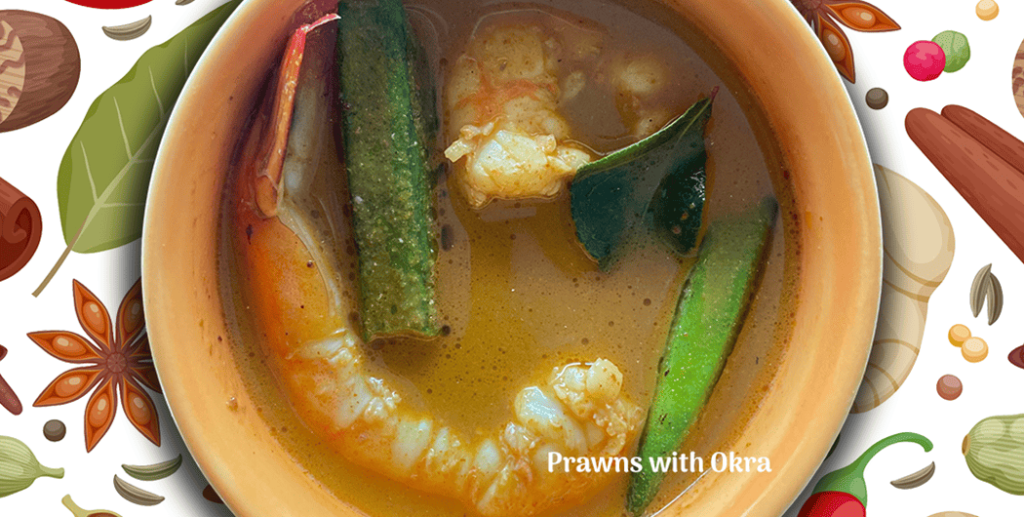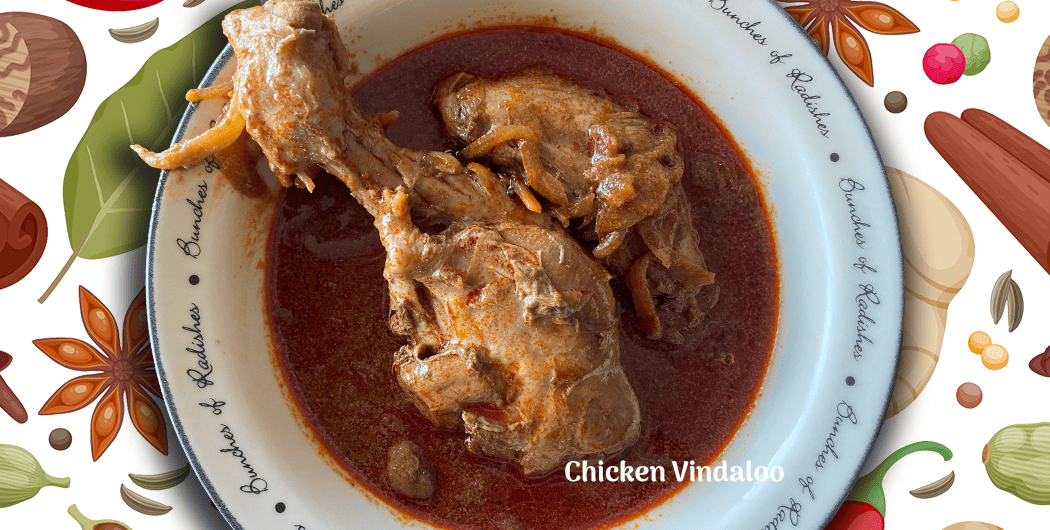This is the quintessential Goan Prawn Curry when you ask for Prawn curry rice in a Goan restaurant. The Okra (Lady’s Finger or Bende in Konkani) is a traditional addition to home made prawn curry and rarely available in restaurants. Soongta is prawn in Konkani language and Hooman essentially means curry or gravy. The Hindu community has perfected this over the years and has made subtle and sometimes not so subtle variations to this dish, like using white radish instead of Okra, and calibrating the chillies used in this recipe. Traditionally, the Soongta Bende Curry is medium spiced, and the coconut milk tempering the heat to a milder degree creating a taste similar to all the other cuisines along the west coast of India. Immensely popular, this orange red curry has come to represent, along with a few other dishes like the Shagotis and Vindaloos, classic Goan cuisine that define Goan traditions and unique identity.
Our Soongta Hooman masala is the consequence of recreating meticulously the spice blend used in Goan Hindu families for generations and reflects the taste and aroma of home made curry. A staple in everyday Goemkar (Goan) cooking, this masala is also suitable for all fish curries especially those made with small fish like Velli (Anchovy) or Lepo (Sole) or Tarlo (Sardine). The following step by step illustrated method will show you how simple it is to arrive at this classic Goan preparation, the way it continues to be made in Goan homes generation after generation. Like all our other masalas, this masala too does all the hard work, needing very little added ingredients, and makes Goan food accessible, desirable, and simple to make, allowing you to be not only an expert in Goan cooking without spending too much time in the kitchen but also a connoisseur of traditional Goan cuisine. Enjoy.
- Medium sized prawns cleaned and deveined: 300g
- Okra: 300g
- Onion: 1 large
- Coconut Milk: 1 Cup (250ml)
- Salt to taste
- The Women of Fatorda Soongta Hooman masala.

Sangita Naik
The recipe of the classic Goan dish Prawns with Okra is from Sangita Naik from the Hindu community of Marlem, an area of Fatorda, and is almost a daily fare in her family. This recipe is handed down to her from her grandmother.
Step 1 – Clean throughly the prawns, and make sure they are deveined. You can also leave the tail on if you so prefer. Make sure that all excess water has been removed. Cut the okra into 2 inch pieces. Avoid cutting them in small bits.

Step 2 – Heat 4 teaspoons of oil in a deep bottomed vessel or pot. Traditionally, coconut oil is used in Goan cooking, but any
refined oil will do.

Step 3 – Add the onion finely chopped, and sauté them for about 2 to 3 minutes.

Step 4 – It will take about 3 to 4 minutes for the onions to become translucent. Before they start to turn golden brown, add
the prawns.

Step 5 – Fry for a minute or two, stirring well. Then, add the okra.

Step 6 – Fry for a couple of minutes, when the water from the prawns starts to ooze out and the okra becomes soft.

Step 7 – Add 3-4 teaspoons of The Women of Fatorda Soongta Hooman masala. You can add more masala if you a prefer
spicier version.

Step 8 – Fry for a minute, stirring continuously until all the prawns are well coated with the masala. Add a cup of coconut milk
and see that the prawns and the okra are just about submerged. Give it a stir.

Step 9 – Cook for another couple of minutes, stirring regularly. Add salt to taste.

Step 10 – Cover it with a lid and reduce the flame to medium. Allow it to cook for another 4-5 minutes.

Step 11 – Remove the lid, and you will see the oil has separated and the prawns and okra are well cooked. Garnish with
chopped fresh coriander leaves.

Step 12 – Serve with brown rice, poi (Goan bread), or chapati.

Note – Though our masala is called Soongta Hooman or prawns curry or shrimp curry, it is a very versatile spice blend and can be used to create a host of seafood curries or even semi-dry dishes depending on your taste. The purpose of the masala is not to just follow tradition but find interesting innovations that introduce us to new flavours and tastes. For example, lightly frying the prawns separately and then adding to the onions imparts a different crunchiness to the dish. Also, instead of okra you can try horseradish or Moringa. Normally, when you use seafood other than prawns or shrimps, no vegetable is added. But then, your imagination is the only limit. Do let us know of your efforts at women@womenoffatorda.in and we’ll feature your recipe on our website. You can upload your recipe here.













